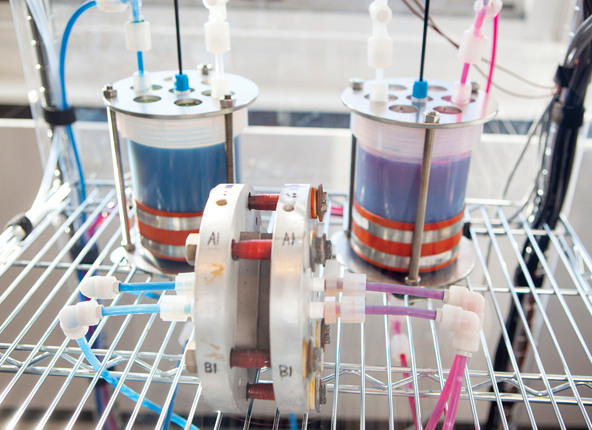Grid-scale battery research flows with ARPA–E support
DOI: 10.1063/PT.3.2342
The storage of large amounts of electricity will be a prerequisite for development in two arenas: making renewable energy a significant portion of the nation’s electricity supply and updating and decentralizing the country’s antiquated power grid to improve the reliability of power generation. Wind and solar power are clean but intermittent energy sources. For example, sunlight is unavailable during the night and is greatly reduced during cloudy periods. Similarly, power from wind turbines waxes and wanes with wind speeds. To achieve an even supply to the grid, utilities are demanding load leveling, or smoothing, when they sign power purchase agreements from wind and solar farms. But most of today’s energy storage systems use pumped hydropower, which is only available in a few places. And existing stationary batteries are too expensive for widespread grid-scale applications.
“Battery cost for storage is killing us,” said David Crane, CEO of NRG Energy, one of the country’s largest generators of electricity, at a Washington, DC, conference in February. His company is involved in building microgrids—small electricity supply systems—that serve off-grid locations. NRG has built more than two dozen solar installations in Haiti and in February announced a venture with Virgin Group founder Richard Branson to develop a renewables-driven microgrid for his privately owned island in the British Virgin Islands. Caribbean islands typically use high-cost diesel generation as a backup power source.
At the consumer end of the grid, many large users would like to reduce their electricity bills by purchasing power at the greatly reduced off-peak nighttime and weekend prices. Grid-scale batteries would provide that capability, but the standard technology, lead–acid, costs $400–$600 per kilowatt hour and can’t last for the thousands of charge–discharge cycles desired to provide a lifetime of 10 years or more.
A huge challenge
Unsurprisingly, improving stationary batteries for utility-scale storage is a major focus of the Advanced Research Projects Agency–Energy. Five years old, ARPA–E is currently funding 21 different advanced grid-scale battery technologies, based on hydrogen–bromine, sodium ion, and other chemistries. Four of the awardees have spawned companies to commercialize their technologies. The target of ARPA–E’s program is lowering the cost of grid-scale batteries to $100/kWh—a price at which storage is competitive with electricity from conventional generation. “That’s a huge challenge, but doable in the long run,” says Craig Evans, CEO of Energy Storage Systems, an ARPA–E awardee developing an iron battery that uses a seawater-like solution for its electrolyte. It’s one of a number of flow batteries backed by ARPA–E. Flow batteries store their positively and negatively charged electrolytes in large tanks, and their energy storage capacity is limited only by the size of the tanks.
Evans says the cost of the Energy Storage Systems battery is now $189/kWh for a system having five hours of storage capacity, but he predicts that it will decline to about $150/kWh once the company scales up to production levels. By comparison, commercially available flow batteries based on vanadium cost around $460/kWh, he says. The company, which received $1.7 million from ARPA–E, is currently field testing 10- to 50-kWh systems at what Evans calls “behind the meter” applications: a winery, a church, and two off-grid businesses.
Alveo Energy says it can already meet the ARPA–E cost target with its flow battery. It uses the inexpensive pigment Prussian blue as the active material in the electrodes, along with an electrolyte of aqueous sodium. The company is in the first year of its three-year, $4 million ARPA–E grant but already has venture capital funding. Alveo is continuing to verify the cost, performance, and lifetime of the cells and expects to build its first prototype batteries later this year. CEO Colin Wessells predicts that his battery will match the $100/kWh target when it is scaled up.
Another awardee, ITN Energy Systems, has received $1.7 million to develop a flow-battery technology invented at the University of Kentucky that requires half the amount of vanadium as currently available versions. That would represent considerable savings, since vanadium electrolyte costs about $200/kWh. The company anticipates additional performance enhancement with a low-cost ion-exchange membrane, which is based on a renewable biopolymer. Thomas Kodenkandath, ITN program manager, says that 500 cycles have been demonstrated to date; ARPA–E’s requirement is 1000. The company is aiming for residential and small-scale applications and for a cost of $1000 per unit. Using other battery technologies, such units now sell for around $4000.
Other flow batteries include one being developed by Harvard University (shown in the photo on page 25).

With a $600 000 grant from the Advanced Research Projects Agency–Energy, Harvard University researchers are developing a grid-scale flow battery that uses an aqueous electrolyte containing inexpensive organic molecules found in plants.
ELIZA GRINNELL, HARVARD SCHOOL OF ENGINEERING AND APPLIED SCIENCES

Duracell technology
Not all the technologies backed by ARPA–E are flow batteries. The City University of New York, working with a $3.5 million grant, is advancing a rechargeable zinc–manganese oxide cell, the same chemistry used in disposable alkaline batteries. CUNY’s original award was extended for a year to support efforts to reduce dendrite formation and extend the life of the anode, says Jerome Fineman of CUNY’s Energy Institute. The battery has achieved 3000 cycles to date, but he says the institute is aiming to push that number to 5000. Meanwhile, a CUNY spinoff, Urban Electric Power, has licensed and begun marketing the Zn–MnO2 battery and a separate zinc–nickel battery developed without ARPA–E funding, for homes with uninterruptible power needs and for home backup power systems in India and other less developed nations. Last year, the company opened a $6.1 million, 5000-m2 R&D and manufacturing facility in New York’s Harlem district, funded in part by state and local agencies.
According to Ann Marie Scuderi, business development manager, the Zn–MnO2 technology could attain the $100/kWh cost target once production is scaled up.
More about the Authors
David Kramer. dkramer@aip.org
